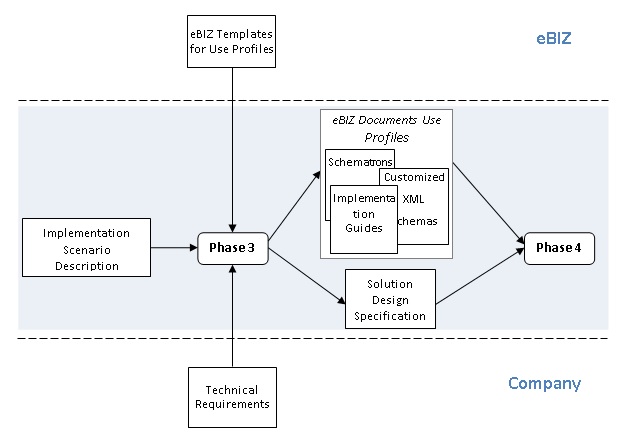| OBJECTIVE: |
To design the set of specification needed for implementing the new solution. |
| OUTPUT: |
- One or more eBIZ document Use Profiles (defined through "Use Profile Implementation Guides", XML Schemas and Schematrons).
- The solution design Specification (defining technical requirements and features for the new software solution).
|
| AVAILABLE RESOURCES: |
- Templates for Use Profiles description, useful for defining the mapping between the abstract data models and the elements of the eBIZ document types.
- Use Profile Design Suite: software tools supporting the developers in customising the Specification and creating the related artefacts ("Use Profile Implementation Guides", customised XML Schemas and Schematrons).
|

Phase 3
STEP 1:
eBIZ documents Use Profiles definition |
At the end of the Phase 2 a set of eBIZ transactions, document types and related abstract data models have been identified.
The objective of this step is to define the eBIZ documents Use Profiles for the defined abstract data models.
This should be achieved performing the following actions for each abstract data model:
- mapping of each data model information in one or more specific elements of the eBIZ documents type;
- definition of the set of business rules setting the useful restriction on the document types; they can:
- forbid the use of not mapped elements;
- make mandatory elements;
- change elements cardinality;
- fix the use of specific code lists or ranges of values;
- fix co-constraints between two or more elements in the document.
- translation of the business rules in artefacts formalizing the Use Profile; these artefacts can be one or both of the following:
- a customized eBIZ XML Schema obtained applying conformance restriction actions to the standard eBIZ XML Schema related to the mapped document type;
- a set of Schematron rules.
- creation of a human-readable representation of the Use Profile (for example the "Use Profile Implementation Guide").
Expected Outputs:
- the eBIZ documents Use Profiles that the new solution should implement, expressed in both human-readable and machine-readable languages (XML Schemas or Schematrons).
If the Business Scenario requires RFId, following additional actions are requested:
- the definition of how the RFId technology is linked to the item (single item, lot, etc.);
- the definition of where (warehouses goods in/outgoing, stores check-out, ..) and how the RFID events are monitored (antennas at the portals, branded devices,…).
|
STEP 2:
Solution design specification |
This step regards the definition of the technical implementation aspects for the new solution.
Describing this step is out of the scope of this document for two reasons:
- it is strictly depending on what the company already has or would adopt, and on the available resources;
- eBIZ has been designed to be platform, technology and language independent, so any kind of solution is possible, but each one requires a specific design approach.
In any case, it is reasonable to think that during this step the following actions should be done:
- the identification of the gap between the Implementation scenario and the current scenario;
- the technical requirements analysis;
- drafting the specifications for the needed development/adaptations/interfaces.
Expected Outputs:
- the Design Specification for the new solution.
|
|
![[PREVIOUS]](/ebiz/images/but_previous.gif)
![[INDEX]](/ebiz/images/but_up.gif)
![[NEXT]](/ebiz/images/but_next.gif)
![[PRINT]](/ebiz/images/but_print.gif)

![[PREVIOUS]](/ebiz/images/but_previous.gif)
![[INDEX]](/ebiz/images/but_up.gif)
![[NEXT]](/ebiz/images/but_next.gif)
![[PRINT]](/ebiz/images/but_print.gif)
![[PREVIOUS]](/ebiz/images/but_previous.gif)
![[INDEX]](/ebiz/images/but_up.gif)
![[NEXT]](/ebiz/images/but_next.gif)
![[PRINT]](/ebiz/images/but_print.gif)

![[PREVIOUS]](/ebiz/images/but_previous.gif)
![[INDEX]](/ebiz/images/but_up.gif)
![[NEXT]](/ebiz/images/but_next.gif)
![[PRINT]](/ebiz/images/but_print.gif)